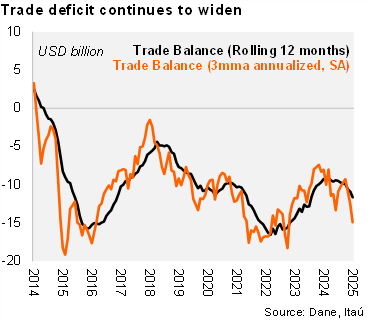The trade deficit in January came in at USD 1.3 billion, widening by USD 0.2 billion with respect to January 2024. The trade deficit was in line with the Bloomberg market consensus and our call. Total imports (FOB) rose by 7.4% yoy (+6.3% in December), boosted by fuels, agriculture, food, beverage and manufactured imports. Meanwhile, exports increased by 4.3% (+0.7% in December), boosted by coffee, but partially countered by a decline in coal exports. As a result, the 12-month rolling trade deficit sits at USD 11 billion (USD 10.8 billion in 2024; USD 9.7 billion in 2023).
Imports gained momentum. The 7.4% yoy increase was boosted by non-durable consumption goods (+24.7% yoy), capital goods for agriculture (+21.5% yoy), fuels (+17.8% yoy) and intermediate goods for industry (+12.5% yoy). In the rolling quarter ending in January, imports increased 8.6% yoy (+7.7% in 4Q24). Imports excluding fuels and transportation equipment rose from last year 11.3% (+12.8% yoy in 4Q24). At the margin, we estimate imports increased 26.8% qoq/saar (+25.9% in 4Q24; -16.1% in 3Q24). Imports from the US accounted for 24.9% of the total in the month.
Exports lose steam. Exports increased 4.3% YoY (+0.7%YoY in December). Coffee sales doubled, partially offsetting the halving of coal exports (due to falling volumes). Meanwhile, oil exports picked up 2.4% (-15%YoY in December). In the rolling quarter ending in January, exports increased a mild 1% yoy (+1% in 4Q24). At the margin, exports fell 14.9% qoq/saar (6.2% in 4Q24). Exports to the US accounted for 30.7% of the total in the month.
Our take: The gradual recovery of domestic demand is being reflected in better import dynamics and therefore a gradual widening of the trade deficit. Nevertheless, elevated transfers will help contain the CAD increase to a still low 2.6% of GDP this year (1.8% in 2024).

